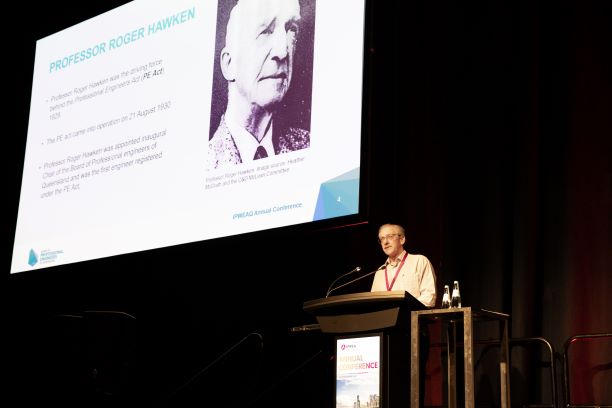14 Dec Setting the standard of engineering

Dawson Wilkie presenting at IWEAQ Annual Conference 2020
At midnight on 12 March 1928 the St Francis Dam in California failed. Several hundred people lost their lives and many more their homes and livelihoods in a disaster considered to be one of the worst civil engineering failures
of the 20th Century. The ensuing investigation into the dam’s failure found that human error and poor engineering judgement were contributing factors.
It has been 50 years since the collapse of Melbourne’s West Gate Bridge. 35 men were killed and a further 18 were injured in what remains as Australia’s worst civil engineering incident. Again, the design of the structure was a focus point of the ensuing investigation.
Professor Roger Hawken did not wait for an engineering incident to occur in Queensland. He realised the impact and consequences of engineering failures could be great. He realised that engineering is not something that can be done by anyone. It is something that requires its practitioners to be highly competent and technically proficient. And he realised that the most effective way of ensuring the competency and proficiency of engineers, setting a professional benchmark and protecting the public was through a mandatory registration scheme, backed by an Act of Parliament. Hawken made it his mission for Queensland
to adopt a registration scheme for engineers and in 1929, the Queensland Parliament passed the first Professional Engineers Act.
‘He realised that engineering is not something that can be done by anyone.’
Registration is accepted and commonplace within many professions – medicine, teaching, law. Indeed, registration is commonly seen as a characteristic of what makes a profession.
Business ethics professor, Daryl Koehn, proposes the following characteristics in defining a professional:
- Are licensed by the state to perform a certain act.
- Belong to an organisation of similarly enfranchised agents that issue standards and/or ideals of behaviour and who discipline one another for breaching these standards.
- Possess so-called ‘esoteric’ knowledge or skills not shared by other members of the community.
- Exercise autonomy over their work, which is not well understood by the larger community.
- Publicly pledge themselves to render assistance to those in need and consequently have special responsibilities or duties not incumbent upon others.
It is important to understand that a registration scheme for engineers – just like the schemes for doctors, teachers and solicitors – does not mean that errors and even accidents will not occur. But public confidence in engineers and their services is based, largely, on an assumption that those practitioners are appropriately qualified and that ‘someone’ is ensuring their practice is of an acceptable standard.
It is the Board’s view that there should be a national scheme, or at least coordination between the states, to register engineers based on the Queensland model.
So how might a national scheme for engineers look and how could it be implemented.
For health practitioners the establishment of a national scheme was introduced from 2008 onward through the Council of Australian Governments. The Health Practitioner Regulation National Law Act 2009 was adopted in each state and territory as state or territory law. The Act establishes regulating entities and a national registration and accreditation scheme for health practitioners and medical students. The Act creates an overarching national body – the Australian Health Practitioner Regulation Agency (AHPRA) – which is responsible for the administration of the national scheme.
Within AHPRA sits the various boards for the different health fields, including the Medical Board of Australia which registers medical practitioners, develops and approves standards and manages and oversees assessments and
investigations referred to it by AHPRA. Beneath the Medical Board of Australia are state and territory boards responsible for making registration and notification decisions about individual medical practitioners.
The objectives of the national scheme are to:
- Provide for the protection of the public by ensuring that only health practitioners who are suitably trained and qualified to practise in a competent and ethical manner are registered.
- Facilitate workforce mobility across Australia by reducing the administrative burden for health practitioners wishing to move between participating jurisdictions or to practise in more than one participating jurisdiction.
- Facilitate the provision of high-quality education and training of health practitioners.
- Facilitate the rigorous and responsive assessment of overseas-trained health practitioners.
- Facilitate access to services provided by health practitioners in accordance with the public interest.
- Enable the continuous development of a flexible, responsive and sustainable Australian health workforce and to enable innovation in the education of, and service delivery by, health practitioners.
As the regulation of professions is within the powers of state and territory governments, the laws around the regulation of health practitioners nationally did not require the Commonwealth to adopt or apply the National Law – for engineers, a national scheme, based on the Queensland model, for the registration of engineers can be created by the states and territories themselves if there is the will.
The benefits will be:
- Improved public safeguards and a ready process to investigate and uphold engineering standards.
- Better engineering standards by requiring minimum qualification and competency standards and ongoing professional development.
- Reduced red-tape and fees to allow a more flexible and responsive engineering workforce.
- Achieving status for the profession by distinguishing qualified and competent professionals from the pretenders.
The vehicle to start the process is through the Building Ministers Forum which is already looking at a registration scheme for engineers in the building sector as part of national reforms recommended in the Shergold-Weir Building Confidence Report. But a national scheme must be wider than just for engineers working in the building space.
All engineers in all industries have the potential to impact the public and should be held to the same standard.
‘But a national scheme must be wider than just for engineers working in the building space.’
From there, draft legislation would be developed and consulted on, with coordination by a national steering committee. Then, state and territory governments would introduce mirror legislation – a Professional Engineer
Regulation National Law Act – based on the Professional Engineers Act. This national law act could create a national body, like AHPRA to administer the national scheme, and state-based entities or boards to register engineers,
develop and approve standards and manage and oversee assessments and investigations.
This is of course a rudimentary plan for how a national scheme for the registration of engineers would look and be implemented but it is something that could realistically be achieved.
As engineers we occupy positions of trust. We are problem solvers, inventors, creators. Because of our public impact we should hold ourselves and our peers accountable to the public and embrace a regulatory system that sets standard and distinguishes qualified and competent professionals, not just in Queensland but right around Australia.
The RPEQ system sets standard for a national scheme for the registration of engineers.
This is an excerpt of the speech given by BPEQ Chair Dawson Wilkie at the IPWEAQ State Conference.
DAWSON WILKIE
Chair and regional representative
BE Civil, FIE Aust, FIPWEAQ, RPEQ, GAICD, CPEng, EngExec, APEC Engineer
Mr Wilkie was first appointed to the Board as Chair and regional representative in January 2015 and was re-appointed in April 2018. A qualified civil engineer working in private consultancy, Mr Wilkie has worked in the profession for more than 35 years. Graduating from the Queensland Institute of Technology…

 MY ACCOUNT
MY ACCOUNT
